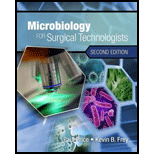
Just as with most living beings, bacteria require the proper conditions to grow and reproduce. Rarely are bacterial cells found alone; so, you could say they are social beings.
During your examination of the topics in this chapter, consider the following:
Do different bacteria prefer different temperatures?
To determine: Whether the bacterial diversity prefer different temperatures.
Introduction: The ability of the microbes to grow under certain conditions is termed as microbial viability. The microbial growth refers to the increase in the number of cells and colonies. The requirements of cell growth, division, and maintenance are categorized as physical and chemical requirements.
Explanation of Solution
Temperature is a physical requirement of the bacteria. Different types of bacteria prefer different temperatures for growth. Depending on the range of temperature in which the growth of bacteria occurs, they are grouped as mesophiles, thermophiles, and psychrophiles. The mesophiles grow at moderate temperatures, thermophiles are heat-loving microbes, and psychrophiles thrive in cold temperatures.
Want to see more full solutions like this?
Chapter 6 Solutions
Microbiology for Surgical Technologists (MindTap Course List)
- Explain in a small summary how: What genetic information can be obtained from a Punnet square? What genetic information cannot be determined from a Punnet square? Why might a Punnet Square be beneficial to understanding genetics/inheritance?arrow_forwardIn a small summary write down:arrow_forwardNot part of a graded assignment, from a past midtermarrow_forward
- Noggin mutation: The mouse, one of the phenotypic consequences of Noggin mutationis mispatterning of the spinal cord, in the posterior region of the mouse embryo, suchthat in the hindlimb region the more ventral fates are lost, and the dorsal Pax3 domain isexpanded. (this experiment is not in the lectures).a. Hypothesis for why: What would be your hypothesis for why the ventral fatesare lost and dorsal fates expanded? Include in your answer the words notochord,BMP, SHH and either (or both of) surface ectoderm or lateral plate mesodermarrow_forwardNot part of a graded assignment, from a past midtermarrow_forwardNot part of a graded assignment, from a past midtermarrow_forward
 Microbiology for Surgical Technologists (MindTap ...BiologyISBN:9781111306663Author:Margaret Rodriguez, Paul PricePublisher:Cengage Learning
Microbiology for Surgical Technologists (MindTap ...BiologyISBN:9781111306663Author:Margaret Rodriguez, Paul PricePublisher:Cengage Learning Comprehensive Medical Assisting: Administrative a...NursingISBN:9781305964792Author:Wilburta Q. Lindh, Carol D. Tamparo, Barbara M. Dahl, Julie Morris, Cindy CorreaPublisher:Cengage Learning
Comprehensive Medical Assisting: Administrative a...NursingISBN:9781305964792Author:Wilburta Q. Lindh, Carol D. Tamparo, Barbara M. Dahl, Julie Morris, Cindy CorreaPublisher:Cengage Learning





